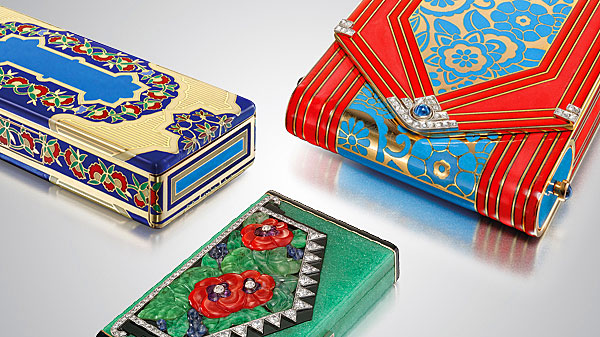The term “box” really doesn’t do justice to the sophistication of the vanity cases, jewellery receptacles and lipstick containers of times bygone. Artfully fashioned from gold or platinum with enamel-set precious stones or mother-of-pearl, such admirable accommodations were as finely-crafted conceits as any of the items of haute joaillerie sported by the most discerning ladies of the day.
While, aesthetically, these distinctly ladylike accessories were veritable masterpieces of creativity and technique, their origins are intriguingly enmeshed with one of the great turning points in feminist history. First coming to the fore during the Art Deco movement of the ’20s and ’30s, they made manifest the growing sense of independence among the more modish ladies of the day. Throughout World War I, after all, a huge number of women had answered their country’s call in a variety of roles. Once hostilities ceased, it was all but impossible to persuade them to adopt solely their more homely responsibilities.
Along with the acceptance that expectations and roles had been forever changed came a sense of joie de vivre, an exuberance that permeated many aspects of the lives of the women of the day. As they started to enjoy their newfound freedom, it became de rigueur to wear make-up and even to smoke in public. It was around this time that bejewelled boxes and cigarette holders made their debut, becoming a symbol of social enfranchisement and sophistication in pretty much equal measure.
[{"id" : "50652","image" : "https://www.gafencushop.com/wp-content/gallery/jewellery-box/Bensimon-vanity-case.jpg","caption" : "Bensimon vanity case"},{"id" : "50655","image" : "https://www.gafencushop.com/wp-content/gallery/jewellery-box/Lac-Burgaut%C3%A9-Box-by-Cartier.jpg","caption" : "Lac Burgauté Box by Cartier"},{"id" : "50657","image" : "https://www.gafencushop.com/wp-content/gallery/jewellery-box/Mother-of-pearl-vanity-case-by-Cartier.jpg","caption" : "Mother-of-pearl vanity case by Cartier"},{"id" : "50659","image" : "https://www.gafencushop.com/wp-content/gallery/jewellery-box/Ostertag-Persian-Style-Cigarette-Case.jpg","caption" : "Ostertag Persian Style Cigarette Case"},{"id" : "50661","image" : "https://www.gafencushop.com/wp-content/gallery/jewellery-box/Poppy-vanity-case-by-Janesich.jpg","caption" : "Poppy vanity case by Janesich"},{"id" : "50663","image" : "https://www.gafencushop.com/wp-content/gallery/jewellery-box/Van-Cleef-Arpels-Amber-and-Snakeskin-vanity-case.jpg","caption" : "Van Cleef & Arpels Amber and Snakeskin vanity case"},{"id" : "50665","image" : "https://www.gafencushop.com/wp-content/gallery/jewellery-box/Van-Cleef-Arpels-box.jpg","caption" : "Van Cleef & Arpels box"},{"id" : "50667","image" : "https://www.gafencushop.com/wp-content/gallery/jewellery-box/Van-Cleef-Arpels-Floral-Sash-vanity-case.jpg","caption" : "Van Cleef & Arpels Floral Sash vanity case"},{"id" : "50669","image" : "https://www.gafencushop.com/wp-content/gallery/jewellery-box/Van-Cleef-Arpels-Noble-Hunt-vanity-and-cigarette-case.jpg","caption" : "Van Cleef & Arpels Noble Hunt vanity and cigarette case"}]
*The jewellery boxes shown here are exhibited at L’ECOLE at K11 Musea until 9 February 2020. Free Admission.



